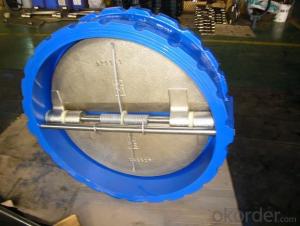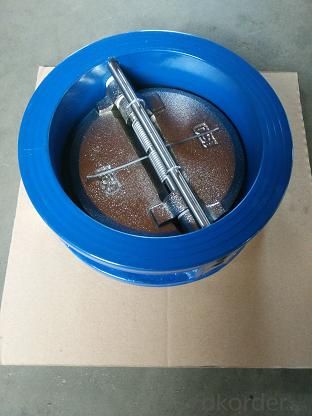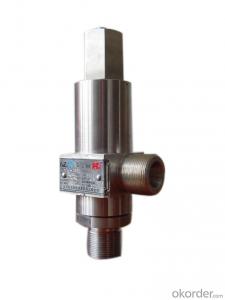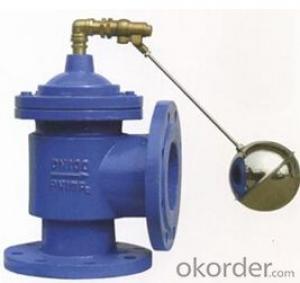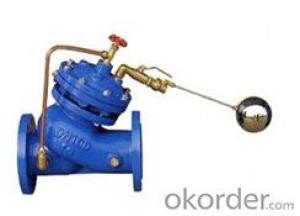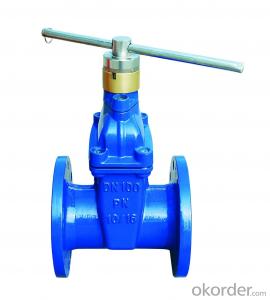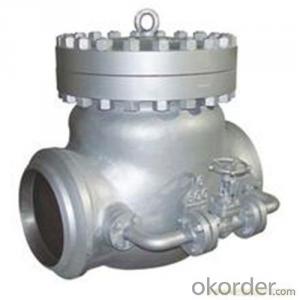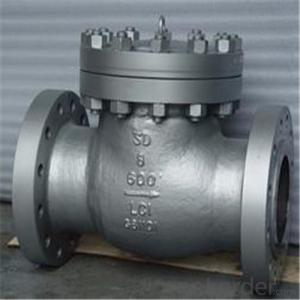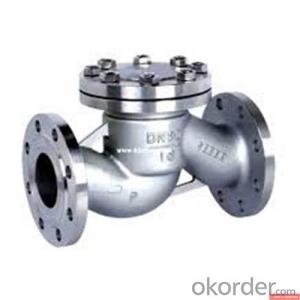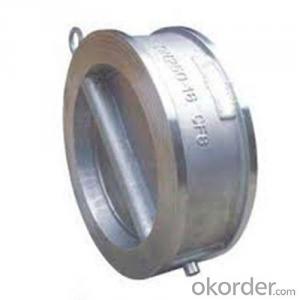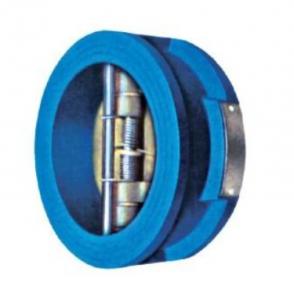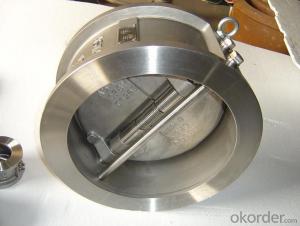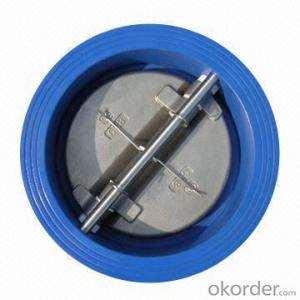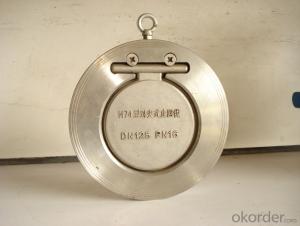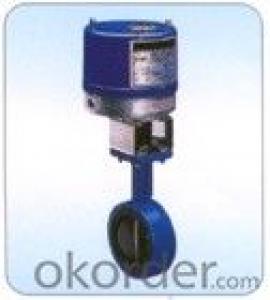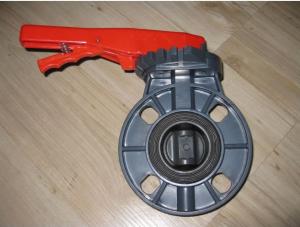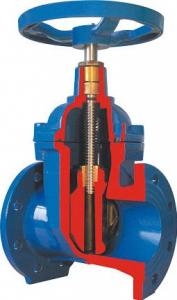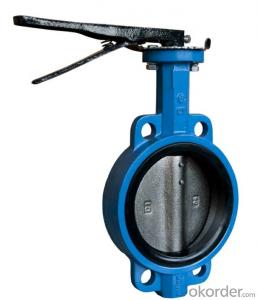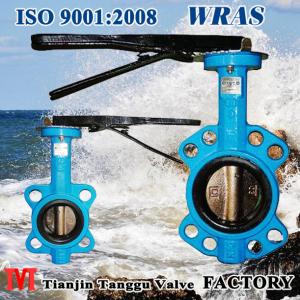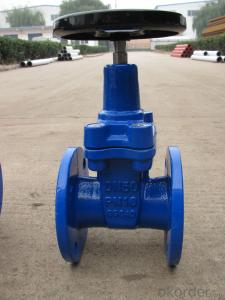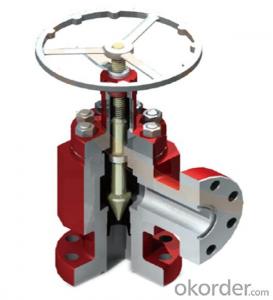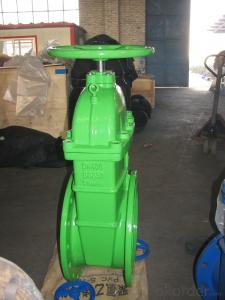wafer type check valve
- Loading Port:
- China Main Port
- Payment Terms:
- TT OR LC
- Min Order Qty:
- -
- Supply Capability:
- -
OKorder Service Pledge
OKorder Financial Service
You Might Also Like
Specifications
Double flanged Double Eccentric Butterfly Valve
PN10/16/25
DN100 ~ DN2000
Technical Specifications
- Design and manufacture: EN593, EN1074-1 and 2
- Face to face dimension: EN558-1 Series 14 (DIN3202 F4)
EN558-1 Series 13 (BS5163)
- Flange dimensions and drillling: EN1092-2 PN10/16/25
- Size range: DN100 - DN2000
- Max. working pressure: 1.0/1.6/2.5 MPa
- Inspection test: EN12266
- Working temperature: -15°C to +80°C
- Suitable medium: water
Main Fetures
- Double eccentric disc reduces seal wear and torque
- Body seat ring is welded directly on the body
- Bi-directional flow and low head loss
- Disc sealing ring to be replaceable on pipeline without dismantling the valve
- Body and disc inside and outside epoxy powder coated (min. 250 microns)
- Opening and closing indicators are provided
- Coupling flange for electric actuator in compliance with ISO5211
- Gearbox and electric actuator operation available
Main Parts and Materials
Body and disc: ductile iron EN GJS500-7/400-15
Shafts: stainless steel AISI 420
Body seat ring: stainless steel AISI 304
Disc sealing ring: EPDM or NBR
Retaining ring: stainless steel or ductile iron
Shaft bearing: Du bushes (self lubricating bushes)
Shaft bush: gunmetal
- Q: non-return valves
- ..?..non-return valves..? I will assume that your 'non-return valves', are what is also known as check valves. Check valves allows flow in one direction only. These are used wherever you need to prevent backflow into the system, or to maintain a charged circuit with fluid, until you choose to unload(depressurize ) it. Now, why are they used in discharged lines of salt water, basically to prevent backflow....reason not known, here , requires usage info.
- Q: HowdyWas taking apart a screw down NR valve and screw lift valve and noticed the spindles were made out of different materials. Brass and Steel.I am aware that brass is non corrosive but why use steel in the other valve? Is it due to their operation, do they come or not come in contact with fluids? Is one cheaper than the other?The screw lift globe valve had a steel spindle and the screw down nr glove valve had a brass spindle.Also, if anyone knows what materials are used in the valve lid and seat are made of.Any ideas?Cheers
- *In steam service , steam flashing is one of the factor which erode the spindle ( say valve stem) *The stem serves as a connector from the actuator to the inside of the valve and transmits this actuation force. Stems are either smooth for actuator controlled valves or threaded for manual valves. The smooth stems are surrounded by packing material to prevent leaking material from the valve. This packing is a wearable material and will have to be replaced during maintenance. With a smooth stem the ends are threaded to allow connection to the plug and the actuator. The stem must not only withstand a large amount of compression force during valve closure, but also have high tensile strength during valve opening. In addition, the stem must be very straight, or have low run out, in order to ensure good valve closure. This minimum run out also minimizes wear of the packing contained in the bonnet, which provides the seal against leakage. The stem may be provided with a shroud over the packing nut to prevent foreign bodies entering the packing material, which would accelerate wear. Disc material: Cast Iron or Ductile Iron Disc Aluminum-bronze Disc Stainless Steel Disc Nickel-plated Ductile Iron Lid material: engineering plastics, Cast Iron. Seat material[hard/soft]: Seats can be integral to the valve body, that is hard metal or plastic. *Hard seat: Hardened steel,Cast Iron,EN-52 forging steel Valve Seats are made from Chrome Alloy Steel which has a high wear resistance at high temperature. Nearly all metal seated valves leak, even though some leaks are extremely small. *Soft seats can be fitted to the valve body and made of materials such as PTFE or various elastomers such as NBR, EPDM, FKM. Each of these soft materials is limited by temperature (rough maximum temperatures are listed below) NBR 80 °C EPDM 120 °C FKM 170 °C PTFE 200 °C
- Q: So it always seems that when I see the jet and foot valve out of a well there's a drop tube between the jet and foot valve. My question concerns this drop tube- is it necessary? I've got a leak somewhere, replaced the foot valve and still have a leak. I'm inclined to get rid of the old drop tube, it's crusty and likely to be the source of leaks either now or in the future. any reason to not just plumb the foot valve directly to the jet? Thank you kindly for useful information.
- The reason for the drop tube is to possibly save you replacing a pump. All wells silt in a certain amount. Your submersible pump can withstand a certain amount of this fine silt but if it gets to be half-submerged in the stuff it will burn out. With the drop pipe in place, the foot valve will plug up first, giving you warning and a chance to shorten the pipe above the pump. Rather than fitting the foot valve directly into the bottom of the pump, you would be better advised to replace the drop tube with a new piece. Also be sure to test your foot valve while you have it out of the well. Some are faulty right out of the box. I always screw on a fitting with a snifter valve that allows me to put 150 psi of air on the foot valve over night. If it doesn't hold that, it shouldn't be at the bottom of a deep well; it's just too much darn hassle pulling them.
- Q: its a vauxhall movara van and i need help im trying to found out wether the valves are broken all the springs are upright and all level , so does this mean there ok ? or not ... thanks
- Cylinder compression test will tell you if you have a broken valve. Thats the best way. The valve might not be broken, it could just be a poor seal.
- Q: How much would it cost to get a new valve cover gasket on a 1993 Nissan Quest van?? I know of a van for sale, but they said it might need a gasket soon. How much plus labor, average, do you think it'll cost? Thanks!!
- www.okorder /
- Q: I was woundering if anyone had a repair manual for this valve on a 2004 Nissan Maxima. I just bought the car and Im getting the P1800 Code. Any help would be appreciated!
- The sensor is very expensive. It cost 199.00 from the dealer
- Q: whaT ARE THE SYMPTON OF A BAD EGR Valve Position Sensor loss of power ?1998 toyota camry v6
- Typically when those sensors start to go bad, the EGR valve doesn't modulate properly between open and closed. When that happens you usually notice a sort of fluttering in the power delivery, often when cruising at a set speed but sometimes also when accelerating as a result of the wrong amount of exhaust gas being recycled back into the engine. You sometimes will notice a loss of power when accelerating as well. If the EGR valve is opening more than necessary it will be allowing more exhaust gas back into the engine than is beneficial....and that will reduce the amount of power the engine produces. If the EGR valve is staying closed more than necessary, you might not notice as many driveability issues but you'll probably notice your average fuel mileage decreasing a little and/or a check-engine light being triggered and/or a failure of an emissions test (even if the check engine light hasn't tripped) if you live somewhere that emissions checks are required.
- Q: i recently adjusted my valves on my 01 civic with a 1.7 sohc vtec motor and i did it to the specs under the hood and i didnt have them too tight or too loose on the feeler gauge and they are pretty loud are these motors just that noisy? has anyone else adjusted them to something different that works better?
- 1.7 SOHC VTEC? I thought that used hydraulic lifters with the small flat plates under the lobes like a subaru or the DOHC older style hondas no? Otherwise i've never adjusted those valves unless they are the same as my old engine like a 1.6 SOHV ---V for valves Where you adjust the top screw and loosen the nut then adjust with the guage. Question are you useing the manual while adjusting from Honda? You can't just take the valve cover off and start sticking the feeler guage at every spot, Do know where each piston is at and at what stroke? also don't get the adjustment wrong for EX. and IN. side because that will just mess everything up even more. Is it high mileage also? and if you know you did it right and it still sounds loud you might have a bent valve or just engine damage like piston slap or something else. I've never had to adjust the valves for that vehicle in all the years i've worked on hondas or acuras, even though they say to adjust every 100k or something we've never had one that was really loud in that model plus those engines are dirt cheap and easy to swap if any engine damage is done... But ya, the honda manual is best for step by step instructions specially when you have to check certain ones at certain piston positions and after you can learn a trick to do it even faster and you can check a few at the same time then turn the engine and check the other ones but theres not enough space to explain in detail if you don't know.... Good luck though....( and do not leave the guage under the valve while your tightening the bolt down, you will squish the guage and then your specs will be off to )
- Q: I'm drawing a complete diagram of the heart, but I'm unsure of the positions of the different valves. I know there are the pulmoary valve, the aortic valve, tricuspid/right AV, bicuspid/left AV, semilunar valves, mitral...but I know there are several names for some of them, like I think the mitral and the bicuspid are the same...but there are so many sources online I don't know which to believe. If anyone knows for absolute sure the right names and where they are it would be very appreciated if you could help :)
- well right= Tricuspid valve left=Mitral valve good luck
- Q: Could I get some possible remedies for Mitral Valve Prolapse pain? I currently am off beta blockers, and I need to cope with the mild, moderate to severe chest pain I experience. Female, average weight for my height, nonsmoker, maybe one alcoholic drink a week, exercise at least 3.5 hours a week. What do others with mitral valve prolapse do that helps?
- Beta blockers are effective in reducing the chest pain related to the mitral valve prolapse syndrome and there are some other lifestyle modification that you can do to help improve your symptoms. It is important though that you be evaluated by your doctor (which I am sure you have) to determine if this chest pain is truly related to the mitral valve prolapse and not some other cause of chest pain. Other causes of chest pain include musculoskeletal, anxiety, heartburn, etc. The treatment for these other causes of chest pain would be different than that for MVP and this is why it is important to determine the exact cause. The lifestyle modification that has been found to be effective for MVP symptoms like chest pain includes aerobic exercise training, the avoidance of stimulants (caffeine), alcohol and undue fatigue, and a reduction in stress. Regular aerobic exercise in people with symptomatic MVP was associated with decreased anxiety, increase general well-being, and a decrease in the frequency of chest pain, fatigue, and dizziness. Magnesium supplementation to individuals who are deficient in Magnesium and have symptomatic MVP was also associated with improvement in symptoms. Magnesium levels can be tested on simple blood tests to determine if you are deficient.
Send your message to us
wafer type check valve
- Loading Port:
- China Main Port
- Payment Terms:
- TT OR LC
- Min Order Qty:
- -
- Supply Capability:
- -
OKorder Service Pledge
OKorder Financial Service
Similar products
Hot products
Hot Searches
Related keywords
